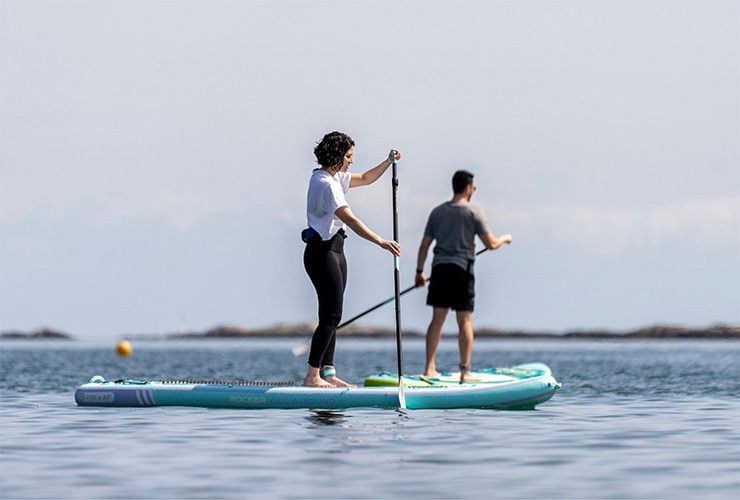When you get on a SUP board for the first time, you’ll quickly start to think it’s not as easy as it looks. You may fall off too often and get worn out too fast. Your paddle board may also not go straight or turn when you want it to. You may even begin to think that stand up paddle boarding is not as fun as people say.
But SUP is not particularly hard.
Here, we’re going to discuss how to actually paddle on a paddle board, the different strokes you need to learn and a few tips on how to make paddling easier. Learning how to move the paddle blade through the water, how to hold your SUP paddle properly and even how to size up your paddle correctly will go a long way in helping to paddle like a pro.
The next time you go paddling you’ll be a little more graceful and you’ll have an idea of what to do.
First Things First: Ensure You Have The Right Sized SUP Paddle
To paddle a SUP board correctly, you need to make sure you have the right length and size paddle (as it’s crucial for learning the correct SUP paddling technique). If you have an incorrectly sized paddle, you might find yourself getting too tired too quickly, as you may be overreaching, or there may just be too much resistance from the paddle blade in the water for you to propel yourself forward easily.
How to Size a SUP Paddle
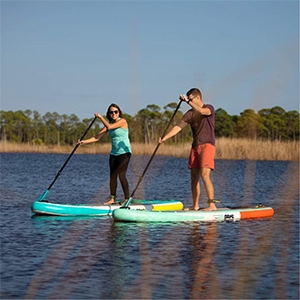
Luckily, sizing a paddle is super easy. There are different methods you can use to find the right length for you.
The first and easiest one is adding about 4 to 8 inches to your height. The number you get should be the proper SUP paddle length for you.
Alternatively, raise your arm up. Hold the paddle straight, parallel to your body with the other hand. Adjust the length of the paddle until the raised wrist rests comfortably on the T-grip.
These are just general rules to guide you. In the end, it comes down to your anatomy and the kind of SUP activity you’ll be doing. For instance, the paddle should be shorter for SUP surfing and longer for SUP racing.
So you can continue to make adjustments as you become more experienced until you get your perfect length, and experiment with different paddle blades to see which size is right.
How to Properly Hold Your Paddle Board Paddle
In addition to having the right size paddle, you should know how to hold it properly too. Otherwise, you’ll struggle to paddle efficiently.
Where to Hold the Paddle
One hand should be on the T-grip and the other on the paddle shaft. But where exactly on the shaft? If your hands are too close or too far apart you’ll have a problem paddling properly.
To find the perfect hand position, place one hand on the T-grip and the other on the paddle shaft. Raise the paddle and place it on your head, parallel to your shoulders. Move the hand on the shaft until both your elbows are at a 90-degree angle. That’s it!
Those are the proper hand positions.
The Paddle Blade Angle Explained: Which Way Should the Paddle Face?
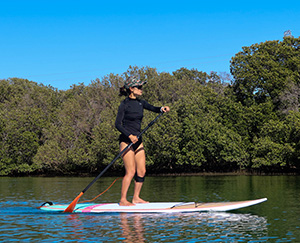
If you look at your paddle’s blade, you’ll notice that it’s at an angle. This is a design meant to minimize drag.
Hold the paddle with the blade facing away from you, and angled forward. It may seem counterintuitive but you’ll notice that a correct blade angle feels right.
Imagine you are scooping some ice cream; you pull the scoop (blade) towards yourself through the ice cream (water). While not perfect, this analogy works with paddle boarding – there’s more resistance this way, and you’ll get more power from your strokes.
Basic Stand Up Paddle Boarding Strokes
Paddle boarding relies mainly on a few basic strokes to help you propel your SUP forward, backward, or make a turn. If you want to learn how to actually paddle your SUP properly, you need to have at least a passing knowledge of and ability to perform these basic strokes.
The Forward Stroke
The forward stroke is the first stroke you should learn as this is the stroke that you use to propel your paddle board forward.
Hold the paddle in the hand positions mentioned above. If your left hand is on the paddle grip, you’ll paddle on the right side. If the right hand is on the grip you’ll paddle on the left side.
Reach forward on your paddling side, as close to the nose of your SUP as you can. Bury the blade completely in the water and push it back. Once the paddle blade gets to your feet, slice it out of the water.
When reaching the blade forward, keep your arms straight and slightly twist your core towards the paddling side, bending your knees a little. This way, you’ll use the bigger muscle groups and avoid wearing out your arms too quickly.
Keep your paddle shaft as vertical as possible and also very close to the SUP rail to make the board go straight. You’ll also need to switch sides after every few strokes to continue in a straight line.
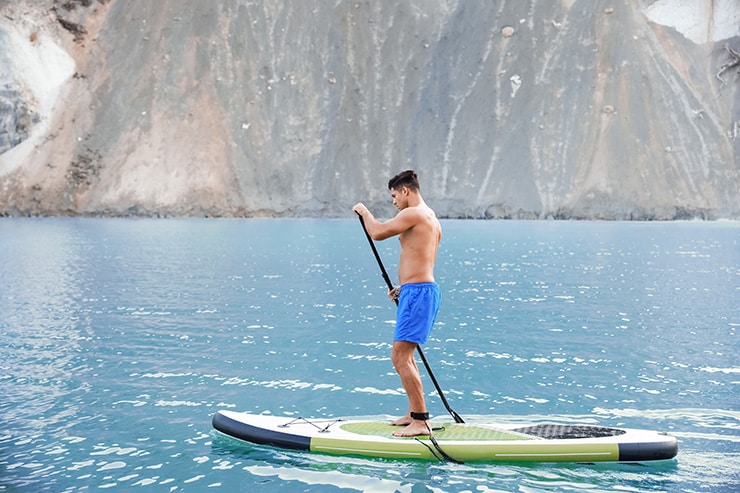
The Reverse Stroke
Just as the name suggests, the reverse stroke is the reverse of the forward stroke. You can use it to stop, slow down, or redirect your board while paddling.
So now instead of reaching forward and planting the blade close to the nose, you reach back and begin your stroke from the back, past your feet, with the paddle flipped so it is facing the opposite way to a forward stroke.
Bring the blade towards the nose of the SUP and slice it out of the water.
The Draw Stroke
This stroke helps you move towards one side. If you’re paddling alongside your buddy and you want to move closer to them, you can use the draw stroke.
Twist your torso in the direction you want to move. Reach to the side and submerge the blade into the water then pull it towards you. The SUP will move in that direction.
The Sweep Stroke
The sweep stroke is used to turn your paddle board.
If you want to turn it to the left, bend your knees a little more and plant your blade close to the nose of the SUP in the opposite direction (your right side). Do a sweep and make a huge arc, ending the stroke right next to the tail of the paddle board.
There’s also a reverse sweep stroke. With this one, you start the paddling stroke next to the tail and draw a large arc with the paddle blade, ending the stroke at the nose of the SUP. If you do it on your right side, the SUP will turn to the right.
Here is a video perfectly explaining the sweep stroke and the reverse sweep stroke.
Other Turning Techniques
When you start getting better at SUP, you can learn an advanced paddling technique or two. Part of learning the correct paddling technique on the water is becoming familiar with stopping and turning.
Some of the more advanced moves will serve you well, so it’s definitely worth familiarizing yourself with these next few tips with regard to turning your board.
Cross Bow Stroke
There’s the cross bow stroke (also known as the cross over turn) which allows for a quick sharp turn without slowing down or losing momentum. To perform the cross bow stroke, you twist your body to the left of the board, with your right shoulder forward. Sweep the SUP paddle across the front of the board in a bow shape, following an arch from left to right all the way to the tail (if you want to turn to the right, just switch sides and do the same move on the opposite side).
Step Back Turm
The step-back turn is another advanced turning technique. As the name suggests, you step back with your leash foot, so it’s more towards the tail, then make a sweeping stroke to turn the board.
These paddling techniques are fun. But make sure you master the basic ones first and learn to maintain your balance before attempting them.
How to Paddle in a Straight Line
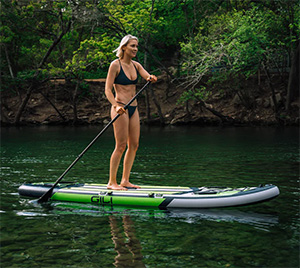
Another problem that many beginners face when paddling is having their SUPs zigzag instead of going straight. This is a problem that can be fixed by learning proper SUP paddling technique.
The first thing you need to do to rectify this is to modify your paddling technique to keep your paddle shaft as vertical as you can and close to the SUP rail, with the blade perpendicular to the rail. Adjust your hand position so that the paddle is straight up and down, and do not paddle at an angle.
You should also reach as far forward as you can when beginning your forward stroke. Then bring the blade to your feet and end the stroke. Don’t let it go past your feet.
Also, remember that you paddle on both sides of a sup – so be sure to keep switching sides every few strokes and keep your eyes focused on the horizon–not your feet or the board.
Wrapping Up
Paddling a paddle board might take practice, but getting the basic paddling techniques locked down is not particularly hard. Correctly holding your paddle, learning the basic SUP strokes and paddling in a straight line will all serve you well when learning paddle boarding. With time, you’ll find these skills easier and you can move on to more advanced techniques.
Remember to adjust your paddle until you’re able to paddle without straining.
Lastly, have fun! Even in the learning process (including making mistakes)–enjoy yourself.

